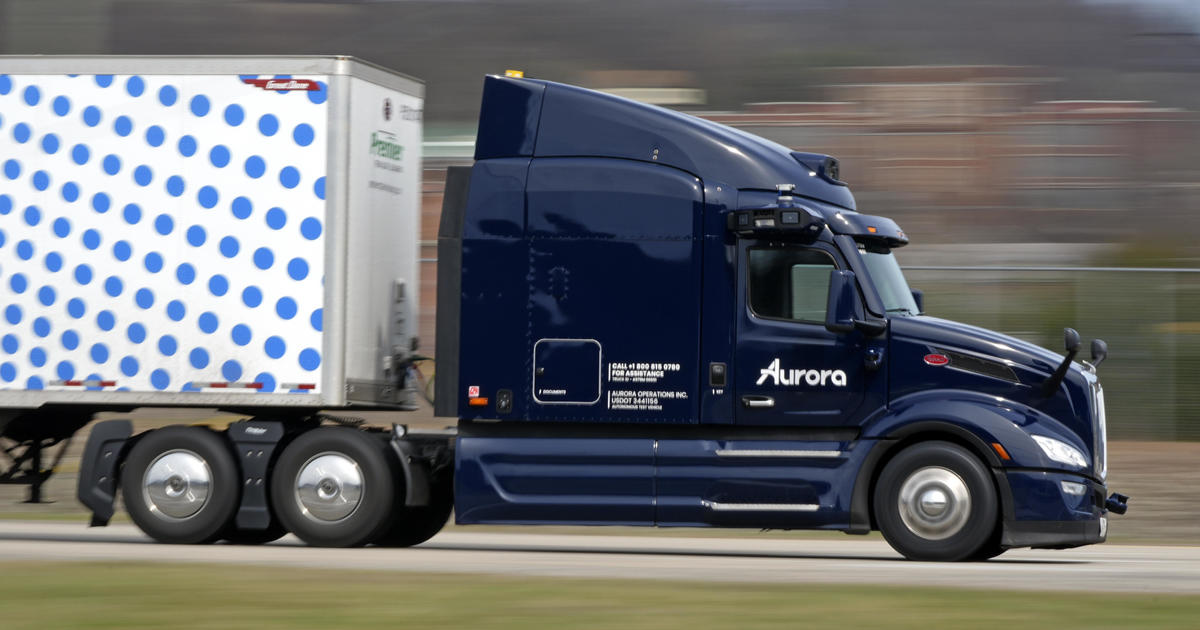Pittsburgh — On a three-lane test track along the Monongahela River, an 18-wheel tractor-trailer rounded a curve. There was no one on board.
A quarter of a mile ahead, the truck's sensors detected a trash can blocking one lane and a tire in another. In less than a second, he signaled, moved to the unobstructed lane, and cleared the obstacles.
The semi-automobile, equipped with 25 laser, radar and camera sensors, is owned by Pittsburgh-based Aurora Innovation Inc. Later this year, Aurora plans to begin hauling freight on Interstate 45 between the Dallas and Houston areas with 20 driverless trucks.
Gene J. Puskar / AP
In three to four years, Aurora and its competitors hope to put thousands of self-driving trucks on public highways in the United States. The aim is for the trucks, which can run almost 24 hours a day without breaks, to speed up the flow of goods, speeding up delivery times.
The image of a fully loaded 80,000-pound driverless truck on a superhighway at 65 mph or more can strike a note of terror. A January AAA poll found that a majority of Americans — 66 percent — said they would be afraid to drive in an autonomous vehicle.
But in less than nine months, trucks with Aurora's systems will begin hauling cargo between terminals for FedEx, Uber Freight, Werner and others. Aurora and most rivals plan to start running freight routes in Texas, where snow and ice are generally rare.
For years, it seemed that the initial adventure of autonomous vehicles would be the journey to big cities. But General Motors' Cruise robotaxi unit is struggling as a result a serious accident. And Alphabet's Waymo faces opposition to expanding its self-driving ride-hailing service in California.
Thus, autonomous trucks are poised to become the first computer-controlled vehicles deployed in large numbers on public roads.
Arguments for and against
But safety advocates warn that with little to no federal regulation, it will mostly be up to companies to decide when semis are safe enough to operate without humans on board.
Aurora and other companies argue that years of testing show their trucks will be safer than human-driven ones. They note that laser and radar sensors in vehicles can “see” further than human eyes. Trucks are never tired, distracted or impaired by alcohol or drugs.
“We want to be out there with thousands or tens of thousands of trucks on the road,” said Chris Urmson, Aurora's general manager. “And to do that, we have to be sure. It's the only way the public will accept it. Frankly, it's the only way our customers will accept it.”
Phil Koopman, a professor at Carnegie Mellon University who studies vehicle automation, agreed that autonomous trucks can theoretically be safer. But he warned that vehicle computers will inevitably make mistakes. And how the trucks fare on real roads, he said, depends on the quality of their safety engineering.
With billions of dollars in investments at stake, Koopman said, he wonders how companies will balance security decisions.
“Everything I see indicates that they are trying to do the right thing,” he said. “But the devil is in the details.”
At the test track, reporters saw Aurora semis avoid simulated road obstacles, including pedestrians, a flat tire, even a horse. The trucks detected obstacles more than a quarter mile away and avoided them.
But they were running at just 35 mph in a controlled environment. (The trucks are being tested with human safety drivers on Texas highways, at higher speeds.)
Since 2021, Aurora trucks have autonomously transported goods more than 1 million miles on public roads with human safety drivers on board. There have been only three crashes, Urmson said, all caused by human driver error in other vehicles.
A federal database started in June 2021 shows at least 13 collisions with other vehicles with autonomous semis, including three with Aurora. In all cases, the collisions were caused by other vehicles.
Background lines
Last month, Urmson said the public company expects to turn a profit in late 2027 or early 2028. To do that, Aurora needs to deploy thousands of trucks, hauling freight and charging customers a per-mile fee.
Aurora, Urmson said, will not compromise safety, even if doing so could delay the realization of profits.
“If we put a vehicle on the road that's not safe enough, that we don't trust the safety of, then it kills everything else,” he said.
The company's competitors — Plus.ai, Gatik, Kodiak Robotics and others — also plan to soon put driverless trucks on the road carrying goods for customers. Gatik expects it this year or next; the others have not established schedules.
Don Burnette, CEO of Kodiak, said freeways are a better environment for autonomous vehicles than cities where robotaxis have been deployed. There are fewer pedestrians and fewer unexpected things happen.
“Accident waiting to happen”
At a mega Buc-ee convenience store along I-45 in south Dallas, the prospect of driverless semis struck a note of fear.
“It looks like a disaster waiting to happen,” said Kent Franz, a high school basketball coach in Chandler, Oklahoma. “I've heard about driverless cars — Tesla, what have you — and the accidents they have suffered. Eighteen wheels? Something so heavy-handed, relying on technology that has proven to be flawed? I don't feel very comfortable.”
There are no federal regulations specifically covering autonomous vehicles, noted Carnegie Mellon's Koopman. And most states don't have one. Consequently, he said, the public must trust companies.
Federal agencies do not have the authority to prevent autonomous vehicles from driving on the roads. However, if something goes wrong, they may require recalls or order trucks out of service.
The companies say the driverless semis can help address a shortage of truckers, estimated by the trucking industry at 64,000 drivers. However, there are also concerns that autonomous trucks will eventually supplant human drivers and cost them their lives.
Aurora's Urmson said he believes the driverless semis will complement the work already done by human drivers.
“If you drive a truck today,” he said, “my expectation is that you can retire driving a truck.”





